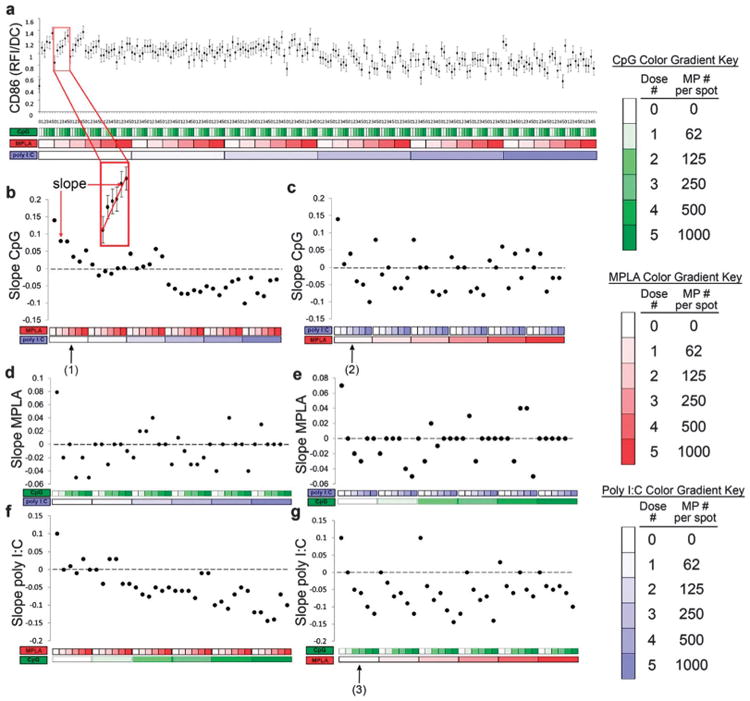Fig. 7.

Analysis of dendritic cell (DC) CD86 expression (RFI) in response to combinatorial adjuvant-loaded microparticles (MPs). (a) CD86 expression (RFI) per DC is plotted against varying amounts of three MP-encapsulated adjuvants (CpG, MPLA and poly I:C; n = 9, with 3 replicates per array on 3 separate arrays). Data is arranged by grouping increasing particle numbers of CpG (green), MPLA (red), and lastly poly I:C (blue) with doses of 0, 62, 125, 250, 500 and 1000 particles per spot, represented by increased shading from lighter to darker colors. The x-axis represents different adjuvant concentrations, and the y-axis represents the expression of CD86 per DC, expressed in RFI. (b and c) Linear fits were calculated for each set of CpG dosing range (lowest to highest number of particles) for every combination of MPLA and poly I:C doses. An example showing the mapping of a single slope is illustrated in the inset. The slope of each linear fit was then calculated and plotted as a function of MPLA and poly I:C doses. Dotted lines represent a slope of zero. (b, arrow # 1) In the absence of poly I:C, the slope of CD86 expression demonstrates a positive response to CpG MPs, and introducing MPLA (red) dampens this effect as seen by the decreasing slope values plotted on the y-axis, with increasing MPLA dose. (b) Introducing poly I:C blocks the dampening effect MPLA has on CpG at lower doses and reverses the positive CD86 response to CpG, as evidenced by the negative slope values, at high poly I:C doses. (c, arrow # 2) In the absence of MPLA, poly I:C decreases CD86 responsiveness to CpG. (c) As MPLA is introduced, it mitigates some of the dampening effect of poly I:C on CpG dependent CD86 expression. (d and e) The adjuvant formulations were then reorganized for every combination dose of CpG and poly I:C. Linear fits were created for the slope of the MPLA response associated with the specific dose of CpG and poly I:C. (d) CD86 expression is modestly upregulated by the presence of MPLA alone (first data point). However, introduction of CpG and poly I:C appears to mitigate this response as most combination doses are near or equal to zero with no apparent trends present. (f and g) The adjuvant formulations were then reorganized for every combination dose of CpG and MPLA. Linear fits were created for the slope of the poly I:C response associated with the specific dose of CpG and MPLA. (f) Increasing CpG dose induces a negative responsiveness to poly I:C. This is further illustrated by reconfiguring the data (g, arrow # 3), showing that in the absence of MPLA, CpG decreases CD86 responsiveness to poly I:C.
